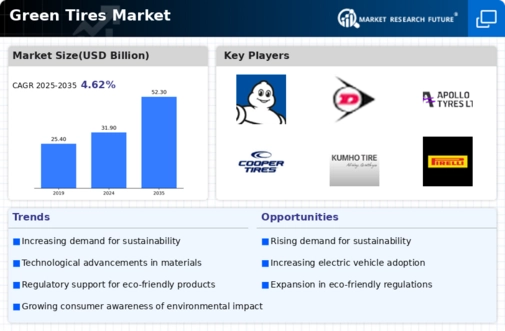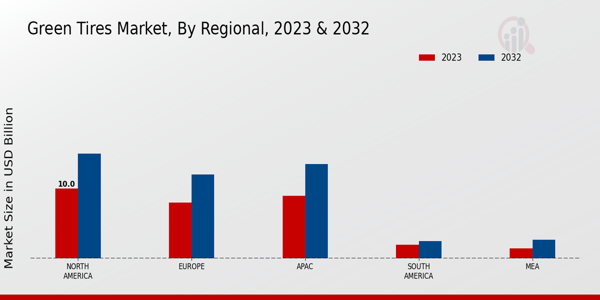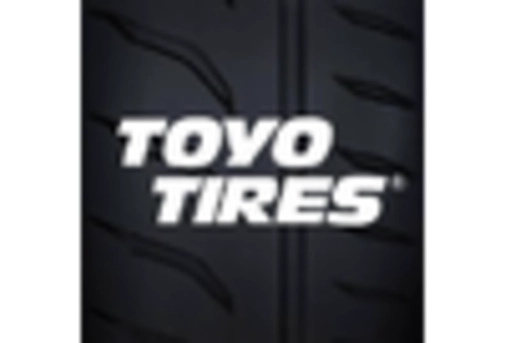Market Analysis
Green Tires Market (Global, 2023)
Introduction
The Green Tyres Market is undergoing a significant change. With the growing importance of the environment for both consumers and manufacturers, the Green Tyres Market is experiencing a transformation. There is a growing awareness of the harmful effects of traditional tyres production and disposal, and a demand for greener alternatives. Green tyres, which are designed to reduce rolling resistance, to save fuel and to be made from sustainable materials, are gaining popularity amongst car manufacturers and consumers who place a premium on the environment. This market is characterised by technological advances, such as the use of sustainable raw materials and the development of low-emission production processes. Regulatory frameworks are tightening and consumer preferences are shifting towards greener products. The Green Tyres Market is therefore well positioned to play a key role in the wider transition towards a more sustainable industry.
PESTLE Analysis
- Political
- In 2023, governments in many countries increasingly advocated the use of green technology, including green tires. The European Union has set a goal of reducing greenhouse gas emissions by at least 55% by 2030, and it has been introduced into the market to stimulate the production of green products. The United States has also allocated about $ 7 billion to promote the development of green tires.
- Economic
- The green tires market is influenced by rising oil prices, which reached an average of $85 per barrel in early 2023. Because of this, consumers and companies are increasingly looking for energy-saving solutions, such as green tires that can save energy. The global automobile industry is also expected to invest about $100 billion in EV technology by 2025, indirectly promoting the demand for green tires that are compatible with EVs and help reduce operating costs.
- Social
- Awareness of the environment has risen to the point where a survey of consumers in 2024 showed that more than two-thirds of them were now willing to pay more for sustainable products, including green tires. This trend in buying behaviour has driven manufacturers to develop and market tires that are more environmentally friendly. Also, social media campaigns promoting sustainable development have further influenced the public’s attitude, leading to a growing demand for products that are in harmony with a more sustainable way of life.
- Technological
- A new technology in the manufacture of rubber tires has been developed which has given them a more lively appearance. In particular, the introduction of biodegradable materials has been greatly increased, so that by 2023 about one-third of the new tires are made from renewable sources. In addition, the recyclability of tires has been improved, and by 2024 about 15 million tons of tires are expected to be recycled. This will help to increase the circular economy.
- Legal
- A more rigorous framework is being established for the manufacture and disposal of tires. In 2023, the EPA introduced a regulation requiring the manufacture of tires to be based on a minimum of 20 percent of recycled rubber by 2025. In addition, the European Union has introduced an eco-labelling system, under which all tire manufacturers are obliged to declare their products' eco-performance, thereby increasing the transparency and costs of compliance for the green tires market.
- Environmental
- A shift from the traditional rubber tires towards greener tires is underway. In 2023, the annual emissions of conventional tires were estimated at around 1.5 billion tons of CO2. Greener tires have lower rolling resistance, which can reduce CO2 emissions by up to 20 percent. Also, the use of sustainable materials in the production of tires is expected to reduce the environmental impact. By 2025, resource consumption in the production of tires is expected to be reduced by 30 percent.
Porter's Five Forces
- Threat of New Entrants
- The Green Tires market has moderate barriers to entry, because of the need for significant investment in technology and production facilities. However, the growing demand for eco-friendly products is attracting new players, which will increase competition. Brands with a loyal customer base and a strong distribution network will have an advantage, but new, disruptive companies with novel technology could also prosper.
- Bargaining Power of Suppliers
- The bargaining power of the suppliers of the Green Tire Market is relatively low. The suppliers of rubber and other raw materials are many, and tire makers can easily change suppliers if the price rises. Suppliers of eco-friendly raw materials have also increased, which further weakens the power of suppliers.
- Bargaining Power of Buyers
- The buyers of green tires have high bargaining power, because of the wide choice of products and the increasing awareness of the environment. Consumers are more informed and are willing to change brands for better prices or a more sustainable choice. This trend puts pressure on the manufacturers to develop new products and offer them at attractive prices to retain their customers.
- Threat of Substitutes
- The threat of substitutes in the Green-Tires market is moderate. The threat of substitutes is a significant threat. While the use of conventional tires remains a viable alternative, the use of electric vehicles and alternative transportation systems poses a significant threat. However, the unique selling proposition of Green Tires—their reduced environmental impact and increased fuel efficiency—offers some protection against this threat.
- Competitive Rivalry
- Competition in the Green Tires market is intense, with many companies competing for market share. The established tire companies are increasingly investing in green technology, while new entrants are entering the market with new products. Competition is fierce, and it is increasingly important for companies to differentiate themselves in terms of quality, sustainability, and branding.
SWOT Analysis
Strengths
- Growing consumer awareness of environmental issues driving demand for sustainable products.
- Technological advancements improving the performance and durability of green tires.
- Supportive government regulations and incentives promoting eco-friendly automotive solutions.
Weaknesses
- Higher production costs compared to traditional tires, leading to increased retail prices.
- Limited availability of raw materials for sustainable tire production.
- Consumer skepticism regarding the performance and longevity of green tires.
Opportunities
- Expansion into emerging markets with increasing vehicle ownership and environmental concerns.
- Partnerships with automotive manufacturers to integrate green tires into new vehicle models.
- Growing trend of electric vehicles creating a niche market for specialized green tires.
Threats
- Intense competition from established tire manufacturers with significant market share.
- Economic downturns affecting consumer spending on premium products.
- Potential regulatory changes that could impact production processes or material sourcing.
Summary
The Green Tires Market in 2023 is characterized by a strong demand for consumers, prompted by a strong awareness of the environment and favorable regulations, and by technological advancements that enhance the performance of products. However, challenges such as higher production costs and consumer skepticism may limit growth. Opportunities for the industry lie in the development of emerging markets and the establishment of alliances with automobile manufacturers. Competition and economic factors may pose a threat to the industry. The industry will be able to take advantage of the trend of sustainable development only if it focuses on innovation and consumer education.














Leave a Comment